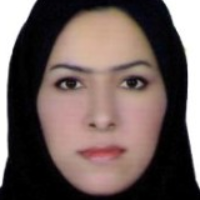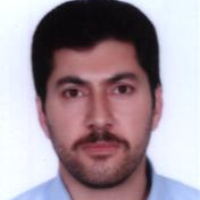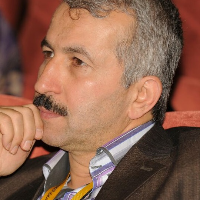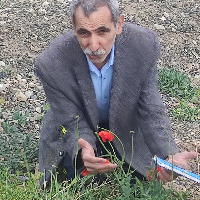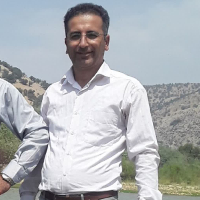a. rahimi
-
پژوهش حاضر با هدف بررسی عملکرد ملکه های اصلاح شده زنبورعسل ایرانی با ملکه های بومی و آمیخته های آنها در سه زنبورستان واقع در اقلیم های متفاوت استان کردستان طی سال های 1401 تا 1402 در قالب آزمایش فاکتوریل 3×3 و بر اساس طرح پایه کاملا تصادفی با نه تیمار و پنج تکرار انجام شد. تیمارها شامل ملکه های زنبورعسل اصلاح شده و جفت خورده در هسته مرکزی طرح کلان اصلاح نژاد زنبورعسل ایرانی، ملکه های آمیخته و ملکه بومی بودند. بعد از آماده سازی کلنی ها در هر زنبورستان، معرفی موفقیت آمیز ملکه ها و سپس همسان سازی کلنی ها بعد از استقرار ملکه ها، صفات آرامش روی سطح قاب، بچه دهی، هموزیگوتی آلل های جنسی، جمعیت (بالغین و نوزادان) و تولید عسل کلنی های زنبورعسل مورد مطالعه در هر زنبورستان مورد ارزیابی قرار گرفت. نتایج تجزیه واریانس نشان داد اثر تیمار، ملکه، زنبورستان و آثار متقابل آنها روی همه صفات مورد مطالعه معنی دار بود (01/0 <P). نتایج مقایسه میانگین ها نشان داد بیشترین میانگین صفات آرامش روی سطح قاب، بچه دهی، جمعیت بالغین و نوزادان مربوط به ملکه های اصلاح شده و کمترین آنها مربوط به ملکه های شاهد بود. همچنین، بیشترین میانگین صفات هموزیگوتی آلل های جنسی و تولید عسل به ترتیب مربوط به ملکه های بومی و ملکه های آمیخته بود. با عنایت به برتری و بهبودهای معنی دار ملکه های اصلاح شده زنبورعسل ایرانی در بیشتر صفات مورد مطالعه در پژوهش حاضر می توان استنباط کرد اصلاح نژاد در راستای بهبود صفات هدف موثر بوده و استفاده از ملکه های اصلاح شده زنبورعسل نژاد ایرانی در راستای افزایش عملکرد کلنی های زنبورعسل کشور توصیه می شود.
کلید واژگان: زنبورعسل، زنبورستان، صفات رفتاری و عملکردی، ملکه اصلاح شده، ملکه بومیIntroductionHoney bees are vital to the economy of the people of Kurdistan Province, Iran. They produce honey and other hive products like royal jelly, wax, venom, and collect pollen and propolis. They also provide food security, create jobs in secondary industries, and prevent rural migration to cities. In addition to their significant role in pollination, they also increase the quantity and quality of agricultural products, develop and expand forests and pastures, preserve biodiversity, and increase income. Despite all these economic and social benefits, honeybee colonies and the beekeeping profession in Iran have been adversely affected by several adverse factors, one of the most important of which is the lack of access for beekeepers to improved, highly productive, and economical queens. The use of improved queens with desirable functional and behavioral traits is one of the most important factors of success in beekeeping. The current study was conducted to evaluate the performance of improved Iranian honey bee queens, "Aram", with native queens and their hybrids in three apiaries located in different climates of Kurdistan province during 2022-2023.
Materials and methodsThe present study was conducted in the form of a factorial experiment (3×3) and based on a completely randomized design with nine treatments and five replications. The treatments included improved and mated queens (improved and mated queens in the central core of the Iranian honey bee breeding plan), hybrid queens (improved and mated queens in the apiaries of Kurdistan province), and native queens (as control). In total, the current study was carried out on 45 honey bee colonies. After the preparation of colonies in each apiary and the successful introduction of queens, the colonies were homogenized in terms of population (adults and brood) and honey storage according to standard instructions. In the present study, the traits of calmness behavior, swarming, homozygosity of sex alleles, population (adults and brood), and honey production were evaluated in the studied bee colonies in each apiary. Data analysis was conducted by SAS 9.4 software.
Results and discussionVariance analysis results of calmness trait showed that the effect of treatment (P<0.01), queen (P<0.01), and the apiary (P<0.05) were significant on the calmness trait of the studied honey bee colonies. Based on the mean comparison results, the highest amount of this trait, with an average of 0.4 ± 0.12 related to the improved queens in the apiary located in the Saral region, and the lowest with an average of 1.7 ± 0.19 related to the native queens in the apiary located in the Genghis Ghalea village. Variance analysis results of swarming trait showed that the effect of treatment, apiary, queen, and the interaction effect of apiary × queen were significant on the swarming trait of the studied honey bee colonies (P<0.01). Based on the mean comparison results, the highest rate of swarming trait with an average of 20 queen cells is related to the native queens of apiary 2 (an apiary located in the Qazalali village), and the lowest rate of this trait with an average of 0.2 queen cells is related to the improved queens of apiary 2 (an apiary located in the Qazalali village). Variance analysis results of homozygosity of sex alleles showed that the effect of treatment and the interaction effect of apiary × queen (P<0.01) and the effect of apiary and queen (P<0.05) were significant on homozygosity of sex alleles of honey bee colonies in the studied apiaries. Based on the mean comparison results, the highest and lowest homozygosity of sex alleles was related to the improved queens of the third apiary (the apiary located in the Saral area) and the hybrid queens of the second apiary (the apiary located in the Qazalali village), respectively. Variance analysis results of the adult population trait showed that the effect of treatment and queen (P<0.01), and the apiary and the interaction effects of queen × apiary (P<0.05) were significant on the adult population trait of the studied honey bee colonies. Based on the mean comparison results, the highest amount of adult population was observed in improved queens of apiary 3, and the lowest in native queens of apiary 3 (apiary located in the Saral region). Variance analysis results of brood population trait showed that the effect of treatment, apiary, queen, and the interaction effects of apiary × queen were significant on the brood population of the studied honey bee colonies (P<0.01). Based on the mean comparison results, the highest average of this trait was related to the improved queens in apiary 3 (the apiary located in the Saral area), and the lowest was related to the native queens of apiary 1 (the apiary located in the Genghis Ghalea village). Variance analysis results of the honey production trait showed that the effect of treatment, apiary, and queen was significant on the honey production trait of honey bee colonies of the studied apiaries (P<0.01). Based on the mean comparison results, the highest production of honey, with an average of 8.2 kg, is related to the improved queens of the second apiary (the apiary located in the Qazalali village), and the lowest, with an average of 3.4 kg, is related to the native queens of the third apiary (the apiary located in the Saral region).
ConclusionsConsidering the superiority and significant improvements of the improved queens of the Iranian honey bee breeding plan in the majority of the traits studied in the current research, it can be concluded that breeding has been effective in improving the target traits. Also, it can be suggested to use improved queens of Iranian honey bees to increase the performance of honey bee colonies in the country.
Keywords: Honey Bee, Apiary, Behavioral, Functional Traits, Improved Queen, Native Queen -
نقش ویتامین ها در تغذیه زنبورعسل به ویژه در مواقعی که تغذیه کمکی با شربت شکر یا جایگزین های گرده مطرح می شود، اهمیت دارد. به همین منظور، جهت بررسی تاثیر ویتامین های تیامین، ریبوفلاوین و ترکیب تیامین-ریبوفلاوین روی رشد جمعیت، صفات عملکردی و ذخایر چربی و پروتئین بدن زنبورها در کلنی های زنبورعسل نژاد ایرانی، آزمایشی در قالب طرح کاملا تصادفی با چهار تیمار و هفت تکرار در بازه زمانی فروردین 1401 تا شهریور 1402 در شرایط اقلیمی استان کردستان انجام شد. تیمارهای آزمایشی شامل: تیمار شاهد (شربت شکر با نسبت یک به یک)، تیمار تیامین با غلظت 1500 پی پی ام به صورت محلول در شربت شکر، تیمار ریبوفلاوین با غلظت 1500 پی پی ام به صورت محلول در شربت شکر، و ترکیب ویتامین های تیامین و ریبوفلاوین با غلظت 1500 پی پی ام به صورت در شربت شکر بودند. صفاتی نظیر جمعیت زنبورهای بالغ و نوزادان، میزان پروتئین و چربی لاشه زنبورها، تولید عسل و مقدار گرده جمع آوری شده در مطالعه حاضر اندازه گیری شد. نتایج نشان داد که جمعیت زنبورهای بالغ و نوزادان، تولید عسل و میزان جمع آوری گرده در کلنی های تغذیه شده با ویتامین های تیامین و ریبوفلاوین و ترکیب تیامین-ریبوفلاوین به طور معنی داری نسبت به کلنی های شاهد بیشتر بود (05/0>P). همچنین، درصد پروتئین و چربی لاشه زنبورهایی که با ویتامین های تیامین، ریبوفلاوین و ترکیب تیامین-ریبوفلاوین تغذیه شدند نسبت به زنبورهای شاهد بیشتر بود (01/0>P). به طور کلی، می توان نتیجه گرفت که استفاده از ویتامین های تیامین و ریبوفلاوین و ترکیب تیامین-ریبوفلاوین باعث بهبود رشد جمعیت، صفات عملکردی و ذخایر چربی و پروتئین بدن زنبورها و افزایش بازده اقتصادی کلنی های زنبورعسل می شود.
کلید واژگان: تیامین، رشد جمعیت، ریبوفلاوین، زنبورعسل، صفات عملکردIntroductionHoney bees need nutrients such as protein, carbohydrates, lipids, minerals, and vitamins. Among nutrients, vitamins are particularly important for their roles in brood rearing, hypopharyngeal gland development, ovary development, longevity, bee immunity, bee weight, and flight muscle development. The vitamins stored in the body of the bees are vitally important in strengthening the immune system, normal growth, and development of broods, producing royal jelly, longevity of bees, and especially wintering quality of honey bees. Among the vitamins required by the honey bees, the most important are thiamine and riboflavin. Pollen quality depends on the supply of vitamins required by honey bees. Most pollen grains are poor and deficient in thiamine and riboflavin. This study aimed to investigate the effect of thiamine and riboflavin on population growth, functional traits, and fat and protein reserves of the bee body in Iranian honey bee colonies.
Materials and methodsAn experiment was conducted in a completely randomized design with four treatments and seven repetitions from April 2022 to September 2023 in the climatic conditions of Kurdistan province, Iran. Experimental treatments included the sugar syrup (control), thiamine (1500 ppm), riboflavin (1500 ppm), and the combination of thiamine and riboflavin (1500 ppm). From the beginning of 14 April 2023, experimental treatments were fed with the mentioned concentrations of vitamins thiamine, riboflavin, and their combination of 0.5 liters every other day for 45 days and 15 days without feeding. Then, traits such as honey production, pollen collection, population (adults and broods), and protein and fat content of carcass were measured in experimental treatments.
Results and discussionThe results of the effect of thiamine, riboflavin, and their combination on the population of adult bees showed that the addition of thiamine and riboflavin in the bees' nutrition was significantly effective in the increase of adult bees' population in the investigated periods as well as the average of the entire period (P<0.05). A comparison of the averages of the experimental treatments revealed that the highest and lowest adult bee populations were associated with the treatments fed the vitamin combination and the control group, respectively. The results of the effect of thiamine, riboflavin, and their combination on the population of broods showed that the addition of thiamine and riboflavin in the diet of bee colonies during the studied periods did not have a significant effect on the increase in the population of newborns, but it showed a significant effect on the average of the entire period (P<0.05). The results of the mean comparison showed that the highest population of broods in the studied honey bee colonies was related to the treatments fed with the combination of thiamine and riboflavin, and the lowest population of broods was related to the control treatment. The results of the effect of thiamine and riboflavin on honey and pollen production traits showed that the use of vitamins and their combination in honey bee nutrition caused a significant increase in honey and pollen production traits of experimental treatments (P<0.05). The results of the mean comparison showed that the highest and lowest amounts of honey and pollen production of the studied honey bee colonies were observed in the treatment fed with the combination of vitamins and the control group, respectively. The effect of thiamine and riboflavin on the carcass protein and fat showed that the use of thiamine, riboflavin, and their combination in feeding the colonies had a significant effect on the amount of carcass protein and fat (P<0.01). A comparison of treatments showed that honey bees in the treatment fed the vitamin combination had the highest carcass protein and fat, and honey bees in the control treatment had the lowest carcass fat and protein.
ConclusionsBased on the results of the present experiment, it could be concluded that the use of thiamine and riboflavin, and their combination in feeding honey bees had a positive effect on population growth, functional traits, and fat and protein reserves of the bees' body in the colonies and improved the performance and increased the economic efficiency of the colony.
Keywords: Thiamine, Population Growth, Riboflavin, Honey Bee, Performance Traits -
این پژوهش به صورت گلدانی در قالب کاملا تصادفی با هشت تیمار به منظور بررسی تاثیر کودهای مختلف و نیز پلیمر سوپر جاذب بر رشد گیاه آگاو اجرا شد. تیمارهای آزمایشی شامل کود دو نوع کود کلات آهن (خارجی و ایرانی)، کلات روی، کود کامل 20-20-20، کود کامل 30-5-15، کود کامل 36-12-12، پلیمر سوپر جاذب و شاهد بود. نتایج نشان داد که بیشترین غلظت ساپونین در تیمار کاربرد کامل 36-12-12 (با میزان 19756 پی پی ام) و کمترین آن در تیمار شاهد (10681 پی پی ام) مشاهده شد. از نظر میزان کلروفیل a، b و کل تیمار کود 20-20-20 بیشترین مقدار را تولید کرد در حالیکه وزن خشک در تیمار کود روی بیشتر از سایر تیمارها بود. اگرچه کلیه تیمارهای کودی باعث افزایش وزن خشک در مقایسه با شاهد شدند، اما بین خود این تیمارها اختلاف معنی داری مشاهده نشد. با توجه به نتایج آزمایش استفاده از کود های کامل و نیز کلات آهن و روی به منظور افزایش میزان متابولیت های گیاه دارویی آگاو (بویژه ساپونین و هکوژنین) توصیه می شود.
کلید واژگان: آگاو، ساپونین، تغذیه، سوپر جاذب، کود نیتروژنThis research was carried out in a completely randomized as potted experiment with eight treatments in order to investigate the effect of different fertilizers and super absorbent polymer on the growth of agave plant. Experimental treatments included two types of iron chelate fertilizer (foreign and Iranian), zinc chelate, complete fertilizer 20-20-20, complete fertilizer 15-5-30, complete fertilizer 12-12-36, super absorbent polymer and control. The results showed that the highest concentration of saponin was observed in the treatment of 12-12-36 (with an amount of 19756 ppm) and the lowest concentration was observed in the control treatment (10681 ppm). In terms of the amount of chlorophyll a, b and total chlorophyll, the 20-20-20 fertilizer treatment produced the highest amount, while the dry weight in the zinc fertilizer treatment was more than the other treatments. Although all fertilizer treatments increased dry weight compared to the control, no significant difference was observed between these treatments. According to the test results, it is recommended to use complete fertilizers as well as iron and zinc chelates in order to increase the amount of agave medicinal plant metabolites (especially saponin and hecogenin).
Keywords: Agave, Saponin, Nutrition, Super Absorbent, Nitrogen Fertilizer -
پلی بوتادین دارای گروه های کربوکسیل انتهایی (CTPB) یک پلیمر پرکاربرد است که به عنوان رزین در ساخت الاستومرها، درزگیرها، عایق های الکتریکی و چقرمه کننده رزین های اپوکسی استفاده می شود. در این مقاله رزین پلی بوتادین دارای گروه های کربوکسیل انتهایی (CTPB) از طریق اکسایش و شکستن زنجیره لاستیک پلی بوتادین و سپس اکسایش گروه های آلدهید انتهایی سنتز شد. شکسته شدن زنجیره لاستیک پلی بوتادین با استفاده از پریدیک اسید انجام شد و با کاهش وزن مولکولی پلیمر، لاستیک جامد به رزین مایع تبدیل شد. این واکنش همچنین منجر به تشکیل گروه های آلدهید در انتهای زنجیره های پلیمری شکسته شده می شود. سپس گروه های آلدهید انتهایی با استفاده از معرف جونز اکسید شدند و رزین CTPB سنتز شد. ریزساختار و سایر مشخصات پلیمرها توسط FTIR، 1H NMR، 13C NMR و GPC تعیین شد. نتایج نشان داد وزن مولکولی (Mn) CTPB حاصل g/mol 1652 و شاخص پراکندگی (PDI) آن 7/2 است. در این روش، محصول با حفظ ریزساختار سنتز شد.
کلید واژگان: پلی بوتادین، رزین، شکستن اکسایشی، پریدیک اسید، گروه کربوکسیلCarboxyl-terminated polybutadiene (CTPB) is a widely used polymer as a resin for fabrication of elastomers, sealants, electric insulation, and as a modifier of epoxy resins. In this paper, carboxyl-terminated polybutadiene resin was synthesized via the oxidative chain cleavage of polybutadiene rubber followed by the oxidation of aldehyde end-groups. The cleavage of polybutadiene rubber was performed using periodic acid and the solid rubber was converted to a liquid resin due to the decrease in the molecular weight of the polymer. This reaction also leads to the formation of aldehyde groups at the end of the cleaved chains. Then, CTPB resin was synthesized by oxidation of terminal aldehyde groups to carboxyl groups using Jones reagent. The microstructure and other properties of the polymers were characterized by FTIR, 1H NMR, 13C NMR, and GPC. The results indicated that the molecular weight (Mn) and functionality (F) of the resulting CTPB are 1652 g/mol and 1.8, respectively. In this method, the product was successfully synthesized with preserved microstructure.
Keywords: Polybutadiene, Resin, Oxidative Cleavage, Periodic Acid, Carboxyl Group -
In this paper, we have proved Diaz-Metcalf inequality for fuzzy integrals. More precisely:\\If $f, g: [0, 1]\to\mathbb{R}$ are continuous and strictly increasing functions, then the fuzzy integral inequality$$ - \hspace{-1em} \int_0^1 f^s d\mu\cdot - \hspace{-1em} \int_0^1 g^sd\mu\le - \hspace{-1em} \int_0^1\left(f\cdot g\right)^sd\mu,$$holds, where $s>1$ and $\mu$ is the Lebesgue measure on $\mathbb{R}$. In addition, we have shown this inequality for pseudo-integrals.
Keywords: Diaz-Metcalf type inequality, Fuzzy integral, integral inequality, pseudo integral -
مجله تحقیقات گیاهان دارویی و معطر ایران، سال سی و هشتم شماره 4 (پیاپی 114، زمستان 1401)، صص 669 -680برای بررسی واکنش برخی از ویژگی های کمی و کیفی گیاه دارویی نعناع فلفلی (Mentha piperita L.) به کودهای آلی تحت تنش کم آبی، آزمایشی به صورت فاکتوریل در قالب طرح بلوک های کامل تصادفی در سال زراعی 98-1397 در مزرعه تحقیقاتی دانشکده کشاورزی دانشگاه ارومیه در سه تکرار انجام شد. تیمارهای آزمایشی شامل کود آلی در پنج سطح (شاهد، کود گاوی (20 تن در هکتار)، کود مرغی (7 تن در هکتار)، ورمی کمپوست (10 تن در هکتار) و کمپوست (15 تن در هکتار)) و رطوبت خاک در سه سطح (50 (تنش شدید)، 70 (تنش ملایم) و90 (شاهد: بدون تنش) درصد رطوبت ظرفیت زراعی) بودند. تنش کم آبی باعث کاهش محتوی فسفر و پتاسیم برگ، ترکیب های فنل و فلاونویید برگ و محتوای رطوبت نسبی برگ و افزایش عملکرد اسانس برگ در مرحله گلدهی کامل شد. بیشترین مقدار اسانس (1.58%) در شرایط تنش ملایم مشاهده شد. کود مرغی و ورمی کمپوست تاثیر معنی دار در افزایش میزان نیتروژن، پروتیین و درصد مهار رادیکال DPPH برگ در شرایط تنش کم آبی نسبت به شرایط بدون تنش داشت. حداکثر عملکرد مربوط به اسانس (32.34 کیلوگرم در هکتار)، وزن خشک ساقه (852.53 کیلوگرم در هکتار)، وزن خشک برگ (1010.40 کیلوگرم در هکتار) و وزن خشک اندام هوایی (1863.93 کیلوگرم در هکتار) در تیمار کود مرغی تحت شرایط آبیاری مطلوب حاصل شد. بنابراین به منظور افزایش عملکرد گیاه، استفاده از کودهای آلی در شرایط تنش کم آبی در راستای نیل به کشاورزی پایدار، توصیه می شود.کلید واژگان: عناصر غذایی، کشاورزی پایدار، ورمی کمپوستTo investigate the response of some quantitative and qualitative characteristics of peppermint (Mentha piperita L.) to organic fertilizers under low water stress, a factorial experiment was conducted in a randomized complete block design with three replications in the research farm of the Faculty of Agriculture of Urmia University in 2017-2018 crop year. Experimental treatments included organic fertilizer at five levels (control, cattle manure (20 ton ha-1), poultry manure (7 ton ha-1), vermicompost (10 ton ha-1), and compost (15 ton ha-1)) and soil moisture at three levels (50 (severe stress), 70 (moderate stress), and 90% (control: without stress) of field capacity). Low water stress decreased the content of leaf phosphorus or potassium, leaf phenols or flavonoids, and leaf relative water content and increased the leaf essential oil yield at full flowering stage. The highest amount of essential oil (1.58%) was observed under moderate stress conditions. Poultry manure and vermicompost significantly increased the amount of nitrogen, protein, and percentage of DPPH radical scavenging of leaves under low water stress compared to without stress conditions. The highest yield of essential oil (32.34 kg ha-1), stem dry weight (852.53 kg ha-1), leaf dry weight (1010.40 kg ha-1), and aerial parts dry weight (1863.93 kg ha-1) was obtained in the poultry manure treatment under optimal irrigation. Overall, organic fertilizers application under low water stress could be recommended to increase the plant yield and achieve sustainable agriculture.Keywords: Nutrients, Sustainable agriculture, Vermicompost
-
Journal of Research in Dental and Maxillofacial Sciences, Volume:7 Issue: 4, Autumn 2022, PP 249 -259Background and Aim
Tooth mobility, which is prevalent among patients seeking dental healthcare services, happens when the tooth is reversibly displaced horizontally or vertically beyond its normal physiological limits. Tooth mobility is classified into 2 subgroups: localized and generalized. Generalized tooth mobility occurs when more than 2 teeth are mobile. In this review, the available studies regarding the common etiologies of generalized tooth mobility are discussed.
Materials and MethodsIn this review article, data were collected by reviewing the available articles published between 2011 to 2021 in national and international journals by searching the PubMed, PubMed Central, Medline, EBSCO, Google Scholar, and Embase databases using the key words “Tooth Mobility”, “Tooth Movement” “Periodontal Disease”, “Systemic Disease”, and “Malignant Disease”. Among the relevant articles, 51 were chosen.
ResultsIt seems that numerous etiologies, which can be either physiological or pathological, can result in generalized tooth mobility.
ConclusionSince an optimal treatment outcome depends on accurate diagnosis, it is crucial for the dentists to be aware of the common etiologies of this condition.
Keywords: Periodontal Diseases, Tooth Mobility, Literature Review -
تنش شوری از عمده ترین تنش های غیرزنده است که با کاهش جذب آب و برهم زدن تعادل عناصر غذایی باعث کاهش رشد گیاه می شود. این آزمایش به منظور بررسی اثر کود نیتروژن در غلظت های بالای شوری بر صفات فیزیولوژیک گیاه کینوا به صورت فاکتوریل در قالب طرح بلوک های کامل تصادفی با دو فاکتور شوری (100، 200، 300، 400 و 500 میلیمولار کلرید سدیم) و نیتروژن نیتراته (50، 100، 150 و 200 میلی گرم در لیتر) با 3 تکرار در گلخانه دانشکده کشاورزی دانشگاه ولی عصر (عج) رفسنجان اجرا شد. صفات مورد مطالعه شامل عملکرد کوانتوم، شاخص کارایی فتوسنتزی، وزن خشک اندام هوایی، محتوی پرولین، قند محلول و مالون دی آلدیید و فعالیت آنزیم های کاتالاز و پراکسیداز بودند. نتایج نشان داد که عملکرد کوانتوم، محتوای پرولین و قندهای محلول تحت تاثیر شوری و نیتروژن قرار گرفتند و افزایش سطح شوری از 100 به 500 میلی مولار باعث افزایش عملکرد کوانتوم، محتوی پرولین و قندهای محلول شد. اما افزایش غلظت نیتروژن از 50 به 200 میلی گرم در لیتر باعث افزایش محتوی پرولین و کاهش محتوی قندهای محلول شد. وزن خشک اندام هوایی، محتوی مالون دی آلدیید، فعالیت آنزیم کاتالاز و پراکسیداز تحت تاثیر برهم کنش نیتروژن و شوری قرار گرفتند. نتایج نشان داد، در سطوح بالای شوری افزایش غلظت نیتروژن به 150 و 200 میلی گرم در لیتر باعث کاهش وزن خشک و محتوی پتاسیم اندام هوایی، افزایش محتوی مالون دی آلدیید و فعالیت آنزیم کاتالاز و گایاکول پراکسیداز و محتوی سدیم اندام هوایی شد. با توجه به نتایج، در شوری های پایین (100 و 200 میلی مولار) و متوسط (300 میلی مولار) مصرف 200 میلی گرم در لیتر نیتروژن و در شوری های بالا (400 و 500 میلی مولار) مصرف 50 میلی گرم در لیتر نیتروژن در محلول غذایی توصیه می شود.
کلید واژگان: آنزیم های آنتی اکسیدان، پرولین، تنش شوری، کود نیتروژن، هالوفیتSalinity stress is one of the major abiotic stresses which injures plants by limited water absorption and nutrient imbalance and limits crop growth. In order to study the effect of nitrogen fertilizer on physiological traits of quinoa at high salt concentrations, a greenhouse experiment was conducted in a factorial arrangement based on a randomized complete block with three replications in 2019. The first factor included 5 levels of salinity (100 (control), 200, 300, 400, 500 mM) and the second factor comprised of 4 levels of nitrogen fertilizer (50, 100, 150 and 200 ppm). Traits that were measured included quantum yield, photosynthetic efficiency index, shoot dry weight, proline content, soluble sugar content, malondialdehyde content, catalase and peroxidase activity, shoot potassium and sodium content. Results showed that quantum yield, proline content and soluble carbohydrate were affected by salinity and nitrogen concentration. With increasing salinity levels from 100 to 500 mM, quantum yield, proline and soluble carbohydrate content increased, but with increasing nitrogen levels from 50 ppm to 200 ppm soluble carbohydrate and proline content decreased and increased, respectively. Shoot dry weight, malondialdehyde content, catalase and peroxidase activity, shoot sodium and potassium content were affected by the interaction of salinity and nitrogen levels. Results showed that at high levels of salinity and increasing nitrogen levels to 150 and 200 ppm, shoot dry weight and shoot potassium content decreased, also malondialdehyde, catalase, and peroxidase activity and shoot sodium content increased. According to these results, in low (100 and 200 mM) and medium (300 mM) salinity levels application of 200 ppm nitrogen and in high salinity (400 and 500 mM) levels application of 50 ppm nitrogen in nutrient solution of quinoa is reasonable.
Keywords: Antioxidant enzyme, Halophyte, Nitrogen fertilizer, Proline, Salt stress -
سابقه و هدف
شناخت عوامل موثر در ایجاد سقوط، نقش مهمی در کاهش مشکل و هزینه های مربوط به درمان آن ایفا می کند. با توجه به متناقض بودن داده ها در مورد استفاده از داروهای کاهنده فشارخون بالا و سقوط در افراد سالمند، این مطالعه با هدف تعیین ارتباط بین مصرف داروهای کاهنده فشار خون بالاو سقوط در سالمندان انجام شد.
مواد و روش هااین مطالعه مقطعی بخشی از فاز اول کوهورت سالمندان شهر امیرکلا بوده که بر روی سه گروه 250 نفری متشکل از سالمندان سالم، مبتلایان به پرفشاری خون با و بدون مصرف داروی کاهنده فشار خون، انجام شد. داروهای کاهنده فشار خون در 6 گروه بر اساس مکانیسم اثر تقسیم شدند. متغیرهای سن، جنس، شاخص توده بدنی، فعالیت فیزیکی، دیابت، تعداد داروها، علایم افسردگی، وضعیت شناختی، تعداد بیماری همراه و نیز فراوانی سقوط در یک سال قبل از شروع مطالعه و در پیگیری شش ماهه با پرسش از افراد سالمند در سه گروه و نیز در دسته های مختلف داروهای کاهنده فشار خون مورد بررسی و مقایسه قرار گرفت.
یافتهها:
از کل سالمندان مورد مطالعه، 126 نفر (16/8%) طی 12 ماه گذشته و 36 نفر (4/8%) طی پیگیری شش ماهه دچار سقوط شدند. ارتباط معنی داری بین سقوط و مصرف داروی کاهنده فشار خون و نیز بین مصرف کلاس های مختلف داروهای کاهنده فشار خون با سقوط پیدا نشد. متغیرهایی همچون علایم افسردگی (2/057 =OR، 0/001=p)، تعداد بیماری های همراه (0/189=OR، 0/006=p) و سن بالاتر (1/033=OR، 0/040=p) نقش موثری در ایجاد سقوط داشتند.
نتیجهگیری:
نتایج مطالعه نشان داد که استفاده از داروهای کاهنده فشار خون و کلاس های مختلف آن با افزایش فراوانی سقوط در سالمندان همراه نمی باشد.
کلید واژگان: سقوط، عوامل کاهنده فشار خون، عوامل خطر، سالمندانBackground and ObjectiveBeing familiar with the factors that are effective in causing falls plays an important role in reducing the issues and costs related to its treatment. Considering the contradictory results about the use of antihypertensive drugs and falls in older adults, the present study was conducted to determine the association between the use of antihypertensive drugs and falls in older adults.
MethodsThis cross-sectional study was a part of the first phase of Amirkola Health and Ageing Project (AHAP), which was conducted on three groups of 250 people including healthy elderly, and hypertensive patients with and without taking antihypertensive drugs. Antihypertensive drugs were divided into 6 groups based on the mechanism of action. The variables of age, gender, body mass index, physical activity, diabetes, number of medications, depression symptoms, cognitive status, number of comorbidities, and the frequency of falls during one year before the beginning of the study and during the six-month follow-up were evaluated and compared in different categories of antihypertensive drugs by asking older adults in the three groups.
FindingsOut of all studied older adults, 126 people (16.8%) fell during the last 12 months and 36 people (4.8%) fell during the six-month follow-up. No significant relationship was found between falls and the use of antihypertensive drugs, and between the use of different classes of antihypertensive drugs and falls. Variables such as depressive symptoms (OR=2.057, p=0.001), number of comorbidities (OR=0.189, p=0.006) and older age (OR=1.033, p=0.040) had an effective role in causing falls.
ConclusionThe results of the study showed that the use of antihypertensive drugs and their different classes was not associated with the increase in the frequency of falls in older adults.
Keywords: Falls, Antihypertensive Agents, Risk Factors, Older Adults -
مجله تحقیقات گیاهان دارویی و معطر ایران، سال سی و هفتم شماره 4 (پیاپی 108، مهر و آبان 1400)، صص 688 -703
به منظور بررسی تاثیر کاربرد کلات آهن و روی و آبیاری تکمیلی بر کمیت و کیفیت شیرابه آنغوزه (Ferula assa-foetida L.)، آزمایشی به صورت فاکتوریل در قالب طرح بلوک های کامل تصادفی با سه تکرار در شهرستان نی ریز (استان فارس) در سال 1397 انجام شد. تیمارهای آزمایشی شامل آبیاری تکمیلی (بدون آبیاری (شاهد)، یک بار آبیاری و دوبار آبیاری) و محلول پاشی کلات روی و آهن (بدون محلول پاشی (شاهد)، محلول پاشی روی (2 در هزار)، محلول پاشی آهن (2 در هزار) و محلول پاشی توام آهن (1.5 در هزار) و روی (1.5 در هزار)) بودند. صفات مورد بررسی شامل تعداد برگ، طول برگ، قطر طوقه، وزن خشک اندام هوایی، درصد زنده مانی بوته ها، غلظت عناصر آهن، منگنز، مس و روی در اندام هوایی، وزن شیرابه و بازده اسانس بودند. نتایج نشان داد اعمال آبیاری تکمیلی باعث افزایش تعداد برگ، وزن خشک اندام هوایی و درصد زنده مانی آنغوزه گردید. محتوی آهن اندام هوایی بیشتری با دوبار آبیاری تکمیلی حاصل شد. همچنین، محلول پاشی کلات آهن و روی باعث افزایش طول برگ و درصد زنده مانی گیاه نسبت به شاهد گردید. بیشترین محتوای آهن اندام هوایی با محلول پاشی کلات آهن بدست آمد. در هر دو شرایط آبیاری تکمیلی و شاهد، محلول پاشی کلات روی و آهن باعث افزایش معنی دار 1.5 برابری حجم بوته، 2 تا 2.8 برابری وزن شیرابه و 0.6 تا 0.9 درصدی بازده اسانس شد. علاوه بر این، در شرایط بدون آبیاری تکمیلی، بیشترین محتوای منگنز اندام هوایی گیاه با محلول پاشی کلات روی و نیز محلول پاشی توام کلات آهن و روی حاصل شد، اما در شرایط یک و دوبار آبیاری تکمیلی، محلول پاشی اثر معنی داری بر این پارامتر نداشت. در هر دو شرایط آبیاری تکمیلی و شاهد، بیشترین محتوای مس اندام هوایی گیاه در تیمار بدون محلول پاشی مشاهده شد. بیشترین میزان روی اندام هوایی این گیاه با محلول پاشی روی حاصل شد. بنابراین به نظر می رسد انجام آبیاری تکمیلی به همراه محلول پاشی کلات آهن و روی، به واسطه بهبود خصوصیات رشدی سبب افزایش عملکرد شیرابه و بازده اسانس آنغوزه شود.
کلید واژگان: آنغوزه (Ferula assa-foetida L.)، درصد زنده مانی، بازده اسانسTo study the effects of different levels of iron and zinc chelates application and supplementary irrigation on the quantity and quality of Ferula assa-foetida L. asafetida, a factorial experiment was conducted in a randomized complete block design with three replications in Neyriz City (Fars province) in 2018. The experimental treatments included the supplementary irrigation (no irrigation (control), once, and twice irrigation) and zinc and iron chelates foliar application (no foliar application (control), Zn (two per thousand) foliar application, Fe (two per thousand) foliar application, and combined Fe (1.5 per thousand) and Zn (1.5 per thousand) foliar application). The studied traits included the number of leaves, leaf length, crown diameter, aerial parts dry weight, plant survival percentage, concentration of elements Fe, Mn, Cu, and Zn in the aerial parts, asafetida weight, and essential oil content. The results showed that the supplementary irrigation increased the number of leaves, aerial parts dry weight, and survival percentage of the plant. Twice supplementary irrigation resulted in the highest aerial parts Fe content. Also, the iron and zinc chelates foliar application increased the leaf length and survival percentage of the plant compared to the control. The highest aerial parts Fe content was obtained by iron chelate foliar application. Under both supplementary and control irrigation conditions, the zinc and iron chelates foliar application significantly increased the plant volume by 1.5 times, asafetida weight by 2 to 2.8 times, and essential oil content by 0.6 to 0.9%. In addition, under no supplementary irrigation conditions, the highest aerial parts Mn content of the plant was obtained by zinc chelate foliar application as well as combined iron and zinc chelates foliar application, but under once and twice supplementary irrigation conditions, the foliar application had no significant effect on this parameter. Under both supplementary and control irrigation conditions, the highest aerial parts Cu content of the plant was observed in no foliar application treatment. The Zn foliar application caused the highest aerial parts Zn content of the plant. Therefore, it seems that the supplementary irrigation with the foliar application of iron and zinc chelates could increase the asafetida yield and essential oil content in F. assa-foetida by improving the growth characteristics.
Keywords: Ferula assa-foetida L, survival percentage, essential oil yield -
فرآیند سنگ زنی یکی از مهم ترین و پرکاربردترین فرآیندهای ماشینکاری جهت رسیدن به کیفیت سطح و دقت ابعادی مطلوب می باشد. از آنجایی که در فرآیند سنگ زنی، ضخامت براده تغییر شکل نیافته یک مقدار ثابت نبوده و برای هر دانه ساینده به طور مستقل و لحظه ای در حال تغییر می باشد، لذا تعیین دقیق ضخامت براده تغییر شکل نیافته لحظه ای جهت مشخص کردن نیروهای سنگ زنی و همچنین توپوگرافی سطح سنگ زنی شده از اهمیت بالایی برخوردار است. مطالعات پیشین در زمینه نیروهای سنگ زنی عمدتا بدون توجه به نوع میکرومکانیزم های بین دانه ساینده و قطعه کار استوار بود، از طرف دیگر با تعیین مقدار متوسط برای ضخامت براده تغییر شکل نیافته فقط مقادیر متوسط نیروهای سنگ زنی قابل محاسبه بود. در این پژوهش برای تعیین ضخامت براده تغییر شکل نیافته لحظه ای و به دنبال آن نیروهای سنگ زنی، یک مدل تحلیلی جدید با رویکرد آنالیز سینماتیکی-هندسی مسیر دانه های ساینده ارایه شده است. این مدل، اجزای تشکیل دهنده نیروهای عمودی و مماسی سنگ زنی (شامل نیروهای لغزش، شخم و برش) را به طور جزیی و دقیق بر اساس ضخامت براده تغییر شکل نیافته لحظه ای حاصل از آنالیز سینماتیکی حرکت دانه ساینده و همچنین بر اساس میکرو مکانیزم های براده برداری بین دانه ساینده و قطعه کار پیش بینی می کند. در پایان آزمایش های تجربی، جهت صحت سنجی مدل تیوری صورت پذیرفت.
کلید واژگان: ضخامت براده جدا نشده لحظه ای، مدلسازی تحلیلی، میکرومکانیزم های براده برداری، نیروهای سنگ زنیThe grinding process is one of the most important and widely used machining processes to achieve the desired surface quality and dimensional accuracy. Since the undeformed chip thickness is not a constant value in the grinding process and is changing independently and momentarily for each abrasive, the determination of the undeformed chip thickness accurately is essential to determine the grinding forces and surface topography of the grinding wheel. Previous studies on grinding forces were mainly regardless of the micro-mechanisms between the abrasive and the workpiece. On the other hand, only the average values of forces could be calculated by determining the average value for undeformed chip thickness. In this study, a new analytical model with the approach of kinematic-geometric analysis of abrasive grain trajectory is presented to determine the undeformed chip thickness and subsequent grinding forces. This model predicts the components of normal and tangential grinding forces (including sliding, plowing, and cutting forces) accurately and in detail based on the instantaneous undeformed chip thickness obtained from the kinematic analysis of abrasive movement and micro-mechanisms between abrasive and the workpiece. In the end, experimental tests were performed to validate the theoretical model.
Keywords: Instantaneous undeformed chip thickness, Analytical modeling, Micro mechanisms of cutting, Grinding forces -
The aim of this research is to fabricate a novel temperature sensor for any calorimetry system. A new mixed solution method was introduced to prepare polystyrene/multiwall carbon nanotube nanocomposite samples with different weight percentages as 0.05, 0.1, 0.28, 1, and 2 of MWCNTs. To demonstrate the dispersion state of the inclusion into the polymer matrix, the SEM analysis was applied. Also, XRD and Raman spectroscopy analyses were carried out. The electrical percolation threshold was investigated and achieved at about 0.28 weight percent of the inclusion. Finally, the electrical resistance of the samples was measured from room temperature up to ~100ºC. Consequently, positive temperature coefficient and negative temperature coefficient effects were observed before and after Tg for the most nanocomposite samples, respectively. The best linear response of the resistance-temperature curve was achieved at 20-50ºC, which using a second-order fitting curve it can be used up t0 ~70ºC. Results show that the polystyrene/multiwall carbon nanotube nanocomposite near the percolation threshold can be used as a temperature sensor for calorimetric purposes.
Keywords: Temperature sensor, Calorimetry, electrical percolation threshold, Polystyrene, MWCNT nanocomposite, Electrical resistance. -
پیشرفت های چشمگیر در صنایع هوافضای ایران طی دهه های اخیر غیرقابل انکار است. پیشرفت هایی که علی رغم تحریم های گسترده بین المللی، از طریق تلاش های درونی حاصل شده است. بنابراین، مطالعه دستاوردهای این حوزه می تواند به عنوان الگویی برای سایر صنایع کشور بویژه صنایع دفاعی باشد. از این رو، این مقاله با بهره گیری از رویکرد پژوهش کیفی و استراتژی پژوهش مطالعه موردی به بررسی مسیر شکل گیری و انباشت قابلیت های فناورانه طراحی و ساخت موشک های بالستیک به عنوان محصولات و سامانه های پیچیده در صنعت هوافضای کشور پرداخته است. یکی از گروه های صنعتی فعال در حوزه صنایع هوافضا به عنوان مورد مطالعه انتخاب شده و در کنار مطالعه منابع علمی و اسناد مرتبط و در دسترس، مصاحبه های عمیق با مسیولین، مدیران، مشاوران و کارشناسان مرتبط با آن سازمان انجام گرفته است. مسیر شناسایی شده برای شکل گیری و انباشت قابلیت های فناورانه در گروه صنعتی مورد مطالعه مشتمل بر هشت گام و چهار نقطه عطف است. یافته های پژوهش نشانگر آن است که علی رغم وجود برخی شباهت ها با الگو های موجود در سایر صنایع و کشورها، تفاوت ها و ویژگی های متمایزکننده ای در الگوی شناسایی شده در این پژوهش وجود دارد.
کلید واژگان: محصولات و سامانه های پیچیده، قابلیت های فناورانه، صنعت هوافضا، فناوریThe significant progresses of Iran’s aerospace industry during last decades are undeniable. In spite of vast and international sanctions against Iran, these progresses were achieved through internal efforts. So, investigating the achievements of these industry can be used by other industries particularly defense industry. In this regard, this paper aims at examining the path of formation and accumulation of design and manufacturing technological capabilities of ballistic missiles in Iran’s aerospace industry as complex product systems, through applying qualitative approach and case study strategy. One of the industrial groups involved in aerospace industry was selected as a case and it was investigated through doing several interviews by its managers and specialists and studying some relevant and available documents. The identified path for formation and accumulation of technological capabilities in this group includes eight steps and four turning-points. The findings show that, in spite of some similarities with previous models of other industries and countries, there are some differences and distinctions in identified model in current research.
Keywords: Complex Product Systems, Technological Capabilities, Aerospace Industry, technology -
برون سپاری پایگاه داده در رایانش ابری یکی از اصلی ترین راهکارها برای حفظ، نگهداری و دسترسی آسان بدون نیاز به سرمایه گذاری کلان، جهت تامین زیرساخت است. معمولا مالکان داده به سرویس دهندگان و تامین کنندگان زیرساخت از نظر صحت نگهداری و دسترس پذیری، اطمینان دارند، ولی نگران حفظ حریم خصوصی و محرمانگی اطلاعات هستند و به همین دلیل ترجیح می دهند داده ها را به صورت رمز شده در سرورهای ابری نگهداری و بازیابی کنند. داده های رمز شده قابلیت جستجو ندارند و نیاز به راهکار، جستجو روی داده های رمز شده در سرور ابری است. یکی از راه حل ها، استفاده از شاخص دهی کلمات کلیدی در کنار پایگاه داده رمز شده است. برای استفاده از این راه حل ها چندین چالش اساسی وجود دارد که می توان به حجم بالای شاخص ها، مواجهه با خطای کاربران و سرعت جستجو اشاره کرد. در این تحقیق برای جبران خطای کاربران، از مجموعه کلیدواژه فازی به جای کلمات ثابت در هنگام جستجو استفاده می شود. همچنین برای کاهش فضای ذخیره سازی با استفاده از روش خوشه بندی کلمات کلیدی، مجموعه کلیدواژه فازی مناسب انتخاب شده و فراداده با حجم کمتر تولید و رمزگذاری می گردد. در اینجا با استفاده از روش های خوشه بندی سلسله مراتبی با سنجه های خاص، کلمات کلیدی مشابه در یک خوشه قرار گرفته و برای پیدا کردن کلیدواژه مورد نظر نیاز به جستجوی همه فراداده نیست و این روش باعث کاهش زمان جستجو می گردد. نتایج عملی و ارزیابی نشان می دهد که طرح پیشنهادی عملی، امن و کارآمد است.
کلید واژگان: رایانش ابری، برون سپاری پایگاه داده، رمزنگاری قابل جستجو، جستجوی فازی، خوشه بندیDatabase outsourcing in cloud computing is one of the main solutions to maintain and access a database easily without the need for large infrastructure investment. Although data owners usually trust service providers and infrastructure providers in terms of maintainability and accessibility, but they are concerned about the privacy and confidentiality of information, and therefore prefer to keep data encrypted on cloud servers. Encrypted data is not searchable, and a solution needs to be provided by the server to search for that data. One solution is to use keyword indexing as metadata alongside the encrypted database. There are several key challenges to using these solutions: high volume of indexes, user error exposure and search speed. In this study, fuzzy keyword sets are used instead of fixed words when searching for users, and in order to reduce storage space using the keyword clustering method, appropriate fuzzy keyword sets are selected and metadata with less production volume is used and encrypted. Using hierarchical clustering methods with specific metrics, the same keywords are placed in a cluster, and to find the desired keyword, it is not necessary to search all metadata and thus the search time is reduced. Practical results and evaluations show that the proposed method is practical, safe and efficient.
Keywords: Fuzzy Search, cloud computing, Database outsourcing, Searchable encryption, Clustering -
نشریه نانو مواد، پیاپی 43 (پاییز 1399)، صص 181 -188
در پژوهش حاضر نانوذرات آلیاژی Fe-Cr-Al به روش انفجار الکتریکی تولید شدند. با استفاده از روش های XRD، TEM و HRTEM ساختار و مورفولوژی نانوذرات تولید شده بررسی شد. نتایج بررسی ها نشان داد ذرات تولید شده شبه کروی تا کروی هستند که احتمالا به دلیل نرخ سرد شدن یکسان و بالای نانوذرات و جوانه های اولیه در همه جهات است. فازهای شناسایی شده از نتایج XRD محلول جامد Fe-Cr با ساختار bcc، اکسید آهن Fe3O4 و ترکیب بین فلزی AlFe بودند. همچنین با تغییر ولتاژ اعمالی از 350 به 380 و 400 ولت، میانگین اندازه ذرات به ترتیب از nm 2/31 به nm 6/27 و nm 5/23 کاهش و نسبت تقریبی فاز اکسیدی به ترتیب از 10 درصد به 11 درصد و 16 درصد افزایش یافت. نتایج تصاویر HRTEM نمونه های تولید شده در ولتاژ 350 و V 380 نشان داد صفحات غالب رشد فاز Fe-Cr از نوع (110) و (200) و در مورد فاز Fe3O4 از نوع (422) است.
کلید واژگان: نانوذرات Fe-Cr-Al، فاز اکسیدی، روش انفجار الکتریکی سیم، HRTEM -
فضاهای عمومی شهری برای آن جام فعالیت های اجباری، اختیاری و مهم تر از همه، فعالیت های اجتماعی هستند و حضور در فضا حق مسلم زنان است و همانند مردان باید از شرایط برابر برای حضور در فضاهای شهری برخوردار باشند. این پژوهش به بررسی میزان انطباق فضا های عمومی منطقه ی 8 تبریز با نیازهای زنان پرداخته است. پژوهش حاضر از نوع کاربردی و از نظر ماهیت، توصیفی- تحلیلی است. 242 پرسشنامه بر اساس فرمول کوکران بین زنان توزیع و داده ها بر اساس تحلیل عاملی اکتشافی و آزمون t تحلیل گردید. میزان آلفای کرونباخ برای پایایی پرسشنامه، 3/88 می باشد که پایایی در حد مطلوب را نشان می دهد. بر اساس مدل تحلیل عاملی اکتشافی سوالات در 4 عامل زیرساخت های فیزیکی، دسترسی، فرهنگی- اجتماعی و امنیت دسته بندی شده است. این 4 عامل در مجموع 32/68٪ از واریانس متغیرها را تبیین می کنند. نتایج تحقیق نشانگر این است که عوامل زیرساخت های فیزیکی، دسترسی و فرهنگی– اجتماعی به ترتیب با سطح معناداری 04/0، 01/0 و 03/0 انطباق مطلوبی با نیاز زنان ندارند؛ اما سطح معناداری عامل امنیت با میزان 217/0 بیانگر وضعیت مطلوب این عامل از نظر پاسخگویان است. با توجه به نتایج و مراجعه ی بالای شهروندان و گردشگران به منطقه، نیازمند توجه بالای مسئولان و نهادهای مرتبط می باشد.کلید واژگان: عدالت جنسیتی، فضاهای عمومی شهری، زنان، تحلیل عاملی، منطقه ی 8 تبریزUrban public spaces are used for compulsory, voluntarily, and, more importantly, social activities and women certainly have the right to play an active role in, and they should benefit from equal right the same as men. This study aimed to address the amount of adaptation of public spaces in zone 8 of Tabriz the needs of women. The present study is applied and, in essence, is descriptive-analytic. 242 questionnaires were distributed, according to the Cochran formula, among women and data were analyzed using Factor-analysis and t-Test. The Cronbach Alpha was 88/3 which is ‘good’. The questions, based on Exploratory Factor Analysis model, have been categorized into four factors: physical, accessibility, social-cultural, and security. Overall, these factors specify %68/32 of variance of the variables. The result shows that the factors of infrastructure of physical, accessibility, social-cultural with the levels of significance, 0/04, 0/01, and 0/03, respectively, are not adapted desirably to the needs of women, but the level of significance for the security factor (0/217) shows a suitable condition through the lens of the respondents. According to results and due to the fact that citizens and tourists visit the zone regularly, this issue should be taken into account significantly by the authorities and the related organizations.Keywords: sexual equity, urban public spaces, women, factor analysis, zone8 of Tabriz city
-
Solar energy is rapidly gaining attention in different industries, especially agricultural industries. Application of this clean energy in drying industry resulted in many investigations in academia. Dryers with energy storage can reduce thermal fluctuations of solar irradiations and also enhance drying efficiency of agricultural products. In this study, paraffin phase change material has been used as energy storage and the performance of a solar tray dryer with indirect forced convection has been investigated. The mathematical model of the energy balance for the process has been derived. The effect of parameters namely inlet air velocity and collector surface area on the final moisture content of samples and air outlet temperature have been studied. Air inlet temperature has been tested at two levels of 1 and 3m/s using a collector surface area of 2m2 with and without energy storage. The integration of energy storage enhances the efficiency by 37% and reduces the outlet moisture content. Lower inlet air velocity and larger collector surface area results in lower final moisture content of samples. On the other hand, for higher ambient temperature even higher inlet air velocity can result in lower moisture content of products. Comparison of experimental data with simulation results shows correlation coefficient of 96.27.
Keywords: Solar Energy, Solar tray dryer, Collector, energy storage -
هنگامی که قرص سوخت هسته ای درون غلاف و رآکتور قرار می گیرد، برخی از اتم های اورانیم شروع به شکافت هسته ای می کنند. در نتیجه تعداد اتم های حاصل بیش تر از اتم های شکافته شده می شود. محصولات جامد تولید شده مشکل زیادی ایجاد نمی کنند، اما محصولات گازی ضمن تورم قرص به فضای خالی بین قرص- غلاف نیز منتقل می شوند. این رفتار موجب تخریب غلاف و کاهش ایمنی رآکتور می شود. بنابراین بهتر است قبل از شروع واقعه، غلاف را از رآکتور بیرون آورد. برای بازده ی مناسب تلاش می کنند مدت زمان استفاده از قرص را افزایش داده و حداکثر انرژی را از قرص بگیرند. به همین منظور، مشکلات و موانع آن را شناسایی کرده و با انجام اصلاحاتی، کارآیی قرص سوخت هسته ای را افزایش داده اند. این پژوهش، مروری بر فعالیت های انجام شده در دنیا در زمینه ی شناخت مشکلات و موانع و راه کارهای ارائه شده برای اصلاح رفتار قرص سوخت هسته ای است. نتایج این بررسی نشان می دهد که از مهم ترین ویژگی های موثر در افزایش عمر و بازده ی تولید انرژی قرص سوخت هسته ای، بزرگی اندازه ی دانه همراه با تخلخل های بین دانه ای با اندازه ی کنترل شده و خواص خزشی و هدایت حرارتی مناسب آن ها هستند.کلید واژگان: قرص سوخت هسته ای، بازده، دانه ی بزرگNuclear fission of uranium atoms starts when a nuclear pellet is placed into the rod and then inside the nuclear reactor. Thus, the number of the produced atoms would be more than those of fission uranium atoms. No problem exists with solid products, but the gas products following the swelling of the pellets enter the gap between the pellet and rod. This causes destruction of the rod and the reactor safety reduction. It is better to exit the rod from the reactor before the event. Attempts are made to increase the life time and the generated energy with nuclear pellets to achieve higher efficiency. For this purpose, after the identification of the obstacles, the efficiency of the nuclear fuel pellets is increased by some modifications. This work is a review of the world activities to identify the obstacles and solutions provided for modifying the nuclear fuel pellets. The results demonstrate that the most important features of a nuclear fuel influence on the life time and efficiency of UO2 feul pellets are the largeness of grains along with intergranular porosities with controlled size, good creep and thermal conductivity properties.Keywords: Fuel pellet, Efficiency, Largeness of grains
-
سابقه و هدف
تنش قلیائیت توسط نمک های قلیایی مانند Na2CO3 و NaHCO3 در خاک ایجاد می شود. تنش قلیائیت جوانه زنی، رشد و تولید گیاهان را تحت تاثیر قرار می دهد. به هر حال تنش قلیائیت به طور مستقیم سبب کاهش رشد گیاه، تغییر در دسترسی مواد غذایی و به هم زدن توازن یونی و مواد معدنی می شود. استفاده از پیش تیمارهای مختلف بذر یکی از روش های تحریک جوانه زنی و رشد گیاه در شرایط تنش است. هالوپرایمینگ یا خیساندن بذرها در محلول های مختلف نمک یکی از این روش های پیش تیمار بذر است که جوانه زنی و ظهور گیاهچه را در شرایط محیطی نامساعد افزایش می دهد. بنابراین هدف این مطالعه بررسی اثر هالو پرایمینگ بذر بر رشد کنجد در شرایط تنش قلیائیت بود.
مواد و روش هابه منظور بررسی تاثیر هالو پرایمینگ بذر بر خصوصیات مورفولوژیک و فیزیولوژیک کنجد رقم GL-13در شرایط تنش قلیائیت، سه آزمایش در آزمایشگاه و گلخانه انجام گردید. در آزمایش اول فاکتورهای آزمایشی شامل پیش تیمار کلریدسدیم با غلظت های 0، 50، 100 و 150 میلی مولار و مدت زمان های 6، 12، 18 و 24 ساعت بود. در آزمایش دوم فاکتورهای آزمایشی شامل پیش تیمار بی-کربنات سدیم با غلظت های0، 10، 20 و 30 میلی مولار و مدت زمان های 6، 12، 18 و 24 ساعت بود. آزمایش سوم با توجه به نتایج دو آزمایش قبل در گلخانه اجرا گردید. در این آزمایش تیمار ها شامل پرایمینگ (شاهد (بدون پرایم)، آب مقطر (هیدروپرایم)، پیش تیمار کلریدسدیم با غلظت 50 میلی مولار و زمان 24 ساعت و پیش تیمار بی کربنات سدیم با غلظت 30 میلی مولار و زمان 18 ساعت) و تنش قلیائیت (0، 15، 30 و 45 میلی مولار بی کربنات سدیم) بود. تنش قلیائیت با استفاده از نمک بی کربنات سدیم (NaHCO3) در محلول غذایی هوگلند تهیه و به گلدان ها اضافه شد. در این آزمایش، طول ساقه و ریشه، پتانسیل عملکرد کوانتوم (Fv/Fm)، شاخص کارایی فتوسنتز، پرولین، کربوهیدرات، مالون دی آلدئید، محتوی پتاسیم، سدیم و نسبت سدیم به پتاسیم اندازه گیری شد.
یافته هابر طبق آزمایش اول بهترین پیش تیمار برای اعمال هالوپرایمینگ در گیاه کنجد پیش تیمار کلریدسدیم با غلظت 50 میلی مولار با مدت زمان 24 ساعت معرفی شد. در آزمایش دوم تیمار بی کربنات سدیم 30 میلی مولار با مدت 18 ساعت به عنوان بهترین پیش تیمار معرفی شد. نتایج آزمایش سوم نشان داد که تنش قلیائیت موجب کاهش طول ساقه، سطح برگ، پتانسیل عملکرد کوانتوم (Fv/Fm)، شاخص کارایی فتوسنتز، غلظت پتاسیم و نسبت پتاسیم به سدیم گردید در حالیکه محتوی پرولین، هیدرات کربن ها، مالون دی آلدئید (MDA) و غلظت سدیم را افزایش داد. تیمارهای مختلف پرایمینگ سبب افزایش طول ساقه، سطح برگ، درصد پتاسیم و نسبت پتاسیم به سدیم نسبت به تیمار بدون پرایم شدند. در تمامی سطوح تنش، تیمارهای مختلف پرایمینگ سبب کاهش میزان مالون دی آلدئید شدند در حالی که Fv/Fm و طول ریشه را افزایش دادند.
نتیجه گیریبه طور کلی نتایج نشان داد تنش قلیائیت رشد کنجد را کاهش داد و در شرایط تنش قلیائیت، هالوپرایمینگ بذر سبب کاهش خسارت غشاء (کاهش مالون دی آلدئید) و بهبود رشد گیاه کنجد گردید.
کلید واژگان: پرولین، جوانه زنی، کنجد، قلیائیت، هالوپرایمینگBackground And ObjectivesAlkalinity stress caused by the alkaline salts such as Na2CO3 or NaHCO3 in the soil. Alkaline stress affected germination, growth and crop productivity. Moreover, the alkalinity stress can directly damage plant growth, alter the availability of nutrients, and disrupt the balance of ions and mineral nutrition. The application of different seed pretreatment methods is one of the ways to stimulate seed germination and growth in stress condition. One of the most common methods is the use of halopriming. Halopriming or soaking of seeds in salt solutions is one of method seed priming, which enhances germination and seedling emergence under adverse environmental conditions. So, the objective of this study was to investigate the effects halopriming on growth of sesame under alkaline stress condition.
Materials And MethodsIn first experiment, factors were priming with NaCl with concentrations 0, 50, 100 and 150 mM for 6, 12, 18 and 24 hours. In second experiment, factors were priming with NaHCO3 with concentrations 0, 10, 20 and 30 mM for different times 6, 12, 18 and 24. Third experiment was conducted basis on result were obtained from two previous tests. In this experiment, factors were priming (non-primed (control), distilled water (hydropriming), NaCl and NaHCO3) and alkalinity stress (0, 15, 30 and 45 mM). Alkaline stress in the pots was created by adding NaHCO3, to half strength Hoagland’s solution. Control plants were only irrigated with half strength Hoagland’s solution. In this experiment, shoot and root height, potential quantum yield (Fv/Fm), performance index (PI), proline, carbohydrate, malondialdehyde content, potassium content, sodium content and sodium to potassium rate were measured.
ResultsResults obtained from first experiment suggested that 50 mM NaCl for 24 hours as the best treatment. Results second experiment suggested that 30 mM of NaHCO3 for 18 hours duration as the best treatment. Results third experiment showed that alkalinity stress reduced shoot length, leaf area, potential quantum yield (Fv/Fm), performance index (PI), potassium content and potassium to sodium rate, whereas increased proline, carbohydrate content and sodium content. Priming different treatments was increased root length, shoot length, leaf area, potassium and potassium to sodium rate compared to control (non-primed). In all of alkalinity levels, priming different treatments decreased malondialdehyde content, whereas increased Fv/Fm and root length.
ConclusionTotally, results showed that alkalinity stress decreased growth of sesame and in alkalinity stress, seed halopriming decreased membrane damage (as indicated by low MDA concentration) and improved plant growth in sesame.
Keywords: Alkalinity, Germination Halopriming, Proline, Sesame -
مجله تحقیقات گیاهان دارویی و معطر ایران، سال بیست و نهم شماره 4 (پیاپی 62، زمستان 1392)، صص 783 -795بهمنظور بررسی اثر تنش خشکی و کود نیتروژن بر خصوصیات مرفولوژیکی و تسهیم ماده خشک اسفرزه (Plantago ovate Forsk)، تحقیقی در سال 1389 در گلخانه تحقیقاتی دانشگاه ولیعصر رفسنجان به اجرا درآمد. آزمایش به صورت فاکتوریل در قالب طرح کاملا تصادفی با سه تکرار انجام شد. فاکتور اول شامل چهار سطح نیتروژن (0، 60، 120 و 180 میلیگرم نیتروژن از منبع اوره در کیلوگرم خاک) و چهار سطح آبیاری (شاهد 100%، 80%، 60% و 40% ظرفیت مزرعه) بود. نتایج نشان داد که اثر متقابل خشکی و نیتروژن بر عملکرد دانه و وزن خشک کل معنیدار است، بهطوری که در شرایط 100% ظرفیت مزرعه بیشترین وزن بذر (72/1 گرم در بوته) در تیمار 120 میلیگرم نیتروژن در کیلوگرم خاک بدست آمد که نسبت به شاهد افزایش 77 درصدی داشت. در تیمار خشکی ملایم (80% ظرفیت مزرعه) مصرف نیتروژن به میزان 120 میلیگرم نیتروژن بر کیلوگرم خاک باعث افزایش 93 درصدی وزن خشک کل نسبت به شاهد (بدون کود) گردید. همچنین، با افزایش تنش خشکی، تسهیم ماده خشک به نفع اندامهای زیرزمینی تمام شده و نسبت ماده خشک ریشه بهطور معنیداری افزایش یافت، هر چند در این شرایط نسبت ماده خشک ساقه و دانه با تغییر معنیداری مواجه نشد؛ اما با افزایش کود نیتروژن نیز ماده خشک بیشتری به سمت برگ منتقل و ماده خشک کمتری به دانه منتقل گردید.کلید واژگان: اسفرزه (Plantago ovate Forsk)، خشکی، انتقال ماده خشک، عملکرد دانهIn this study, the effects of drought and nitrogen were analyzed on morphological traits and dry matter allocation of Isabgul (Plantago ovata) at Vali-e-Asr University of Rafsanjan in 2010. The research was conducted using factorial experiment based on RCD design with 3 replications. The factors included nitrogen (0, 60, 120 and 180 mg N.Kg-1 soil) and soil moisture (100, 80, 60, 40 % FC). Results indicated that drought, nitrogen and their interaction significantly affected seed yield and total dry weight. The highest seed yield (1.72 g.plant-1) was obtained at 120 mg N.Kg-1 soil which was 77% higher than that in control. In 80% FC treatment, using 120 mg N.Kg-1 soil caused 93% increase in total dry weight, compared to control. In addition, with increasing drought stress, dry matter partitioning benefited the root and root mass ratio (RMR) increased significantly. However, no significant changes were recorded for shoot mass ratio (SMR) and grain mass ratio (GMR). Also, with increasing nitrogen fertilizer, more dry matter was transferred to the leaves and less dry matter was transferred to the seed.Keywords: Isabgul (Plantago ovate Forsk), Drought Stress, dry matter distribution, seed yield
-
به منظور تعیین اثر اصلاحی کلسیم و پتاسیم در شرایط تنش شوری بر محتوای پرولین، کلروفیل، پروتئین و رشد گیاه زنیان (Carum copticum L.)، آزمایشی به صورت فاکتوریل در قالب طرح پایه بلوک های کامل تصادفی با چهار تکرار در گلخانه تحقیقاتی دانشگاه ولی عصر رفسنجان در سال 1388 اجرا شد. فاکتور اول شامل شوری با سه سطح (صفر، 50 و 100 میلی مولار) و فاکتور دوم شامل محلول غذایی در پنج سطح N1 (محلول غذایی هوگلند)، N2 (محلول غذایی هوگلند + CaCl2 با غلظت 40 میلی مولار در محلول غذایی)، N3 (محلول غذایی هوگلند +CaCl2 به صورت اسپری با غلظت 20 میلی مولار بر روی شاخساره ها)، N4 (محلول غذایی هوگلند + KNO3 با غلظت40 میلی مولار به صورت محلول همراه با آب آبیاری) و N5 (محلول غذایی هوگلند + KNO3 به صورت اسپری با غلظت20 میلی مولار بر روی شاخساره ها) بود. نتایج نشان داد که نوع محلول غذایی تاثیری بر محتوای پرولین نداشت و بیشترین میزان پرولین در سطوح شوری S2 و S3 مشاهده گردید. افزایش شوری باعث کاهش معنیداری در میزان کلروفیل a، b و کل گردید. بیشترین میزان پروتئین در سطح تیمار شاهد و کمترین میزان آن در تیمار شوری 100 میلی مولار مشاهده شد. همچنین بیشترین میزان پروتئین در محلول غذایی N3 و کمترین میزان آن در محلول غذایی N5 مشاهده شد. نوع محلول غذایی بر سطح برگ اثر معنیداری داشت، به طوری که بیشترین سطح برگ در محلول غذایی مربوط به N5 مشاهده شد. در مجموع نتایج این پژوهش نشان داد که گیاه زنیان شوری تا 50 میلی مولار را به خوبی تحمل می کند و محلول پاشی پتاسیم و کلسیم برای کاهش خسارت شوری بر خصوصیات رشدی گیاه زنیان، بهتر از کاربرد آنها در محلول غذایی می باشد.
کلید واژگان: زنیان (Carum copticum L _)، اصلاح شوری، آنالیز رشدIn order to investigate the effects of supplementary calcium chloride and potassium nitrate on proline, protein content, chlorophyll and growth of Ammi (Carum copticum L.) under different salinity levels and nutrient solutions (NS), a RCBD design with factorial arrangement was conducted at the Agriculture Research Field, Vali-e-Asr University of Rafsanjan, during September 2009. The treatments were three levels of salinity (0, 50 and 100 mMol) and five different nutrition solutions including: Control: Hoagland solution only (N1); Hoagland solution plus 20 mM CaCl2 in nutrition solution (N2); Hoagland solution plus 20 mM CaCl2 as spray (N3); Hoagland solution plus 20 mM KNO3 in nutrition solution (N4) and Hoagland solution plus 20 mM KNO3 as spray (N5). Results showed that proline content was significantly affected by salinity and the type of nutrient solution and their interactions. Increasing salinity, especially at 100 Mmol NaCl, significantly reduced chlorophyll a,b and total chlorophyll. Chlorophyll a, b and total chlorophyll content were not significantly affected by the type of nutrition solution. The highest and lowest protein content were observed by control and 100 Mm NaCl treatments respectively. The type of nutrient solution also influenced protein content. The highest and lowest protein contents were related to N3 and N5, respectively. Total dry weight and stem dry weight were significantly reduced by salinity while root dry weight was not affected by salinity. The highest leaf area was achieved on control and nutrition solution N5. Generally, it is concluded that Ammi could tolerate salinity up to 50 mMol NaCl and leaf spraying of Ca and K would be better to ameliorate salinity rather than using in nutrition solution.
Keywords: Ammi (Carum copticum L.), growth analysis, salinity amelioration -
پوشش های هیبرید آلی- معدنی با نانوذرات هسته/پوسته SiO2-TiO2 به منظور توسعه پوشش های خودتمیزشونده و مقاوم در برابر خوردگی تهیه شدند. نانوذرات TiO2 آناتاز توسط روش سل-ژل در دو شرایط دمای بالا و دمای پایین تهیه شده و جهت تایید ساختار بلوری به وسیله آزمون تفرق پرتو ایکس مورد بررسی قرار گرفت. برای بررسی اندازه و شکل ذرات در سل TiO2 بی شکل و نیز برای مشاهده ضخامت لایه سیلانی بر روی نانوذرات آناتاز از آزمون میکروسکوپ الکترونی عبوری استفاده شد. فعالیت فوتوکاتالیستی پوشش ها توسط تخریب متیلن آبی تحت نور فرابنفش بررسی و با نمونه شامل دی اکسید تیتانیم صنعتی دگوسا 25P مقایسه شد. نتایج نشان داد که فعالیت فوتوکاتالیستی پوشش ها به میزان بلورینگی و اندازه نانوذرات آناتاز مربوط می شود. برای بررسی تاثیر فعالیت فوتوکاتالیستی بر میزان مقاومت خوردگی پوشش ها، نمونه ها به مدت 1080 ساعت در معرض نور فرابنفش قرار داده شد. نمودارهای تافل نمونه ها نشان داد که هرچه فعالیت فوتوکاتالیستی پوشش بیشتر باشد به همان اندازه از میزان مقاومت خوردگی پوشش با گذشت زمان در معرض نور فرابنفش کاسته می شود.
کلید واژگان: پوشش های هیبریدی، خوردگی، سل، ژل، فوتوکاتالیست، نانوذرات هسته، پوسته، آناتازInorganic-organic hybrid coatings with TiO2-SiO2 core/shell nanoparticles were prepared in order to develop the self-cleaning and corrosion resistant coatings. As proved in XRD test, the anatase TiO2 nanoparticles were prepared by sol-gel method in two different thermal conditions namely high temperature and low temperature process. The size and the shape of the particles in amorphous TiO2 sol and the thickness of SiO2 layer on the anatase nanoparticles revealed a core/shell structure by transmission electron microscopy. The photocatalytic activities of the coatings using the prepared TiO2-SiO2 nanoparticles were investigated via the decomposition of methylene blue (MB) under UV-radiation and compared with those samples prepared using commercial TiO2, i.e. P25 Degussa. It was found that the photocatalytic activity of the coatings was significantly attributed to the crystallinity and the particle size of anatase nanoparticles. To find out the effect of photocatalytic activity on the corrosion resistance, the nanocomposites coatings were exposed under UV for 1080 h. The Tafel curves of the samples showed lower corrosion resistance for the coatings of higher photocatalytic activity. J. Color Sci. Tech. 7(2013), 151-164©. Institute for Color Science and Technology.
Keywords: Hybrid coatings, Corrosion, Sol, gel, Photocatalyst, Core, shell nanoparticles, Anatase -
-
به منظور ارزیابی اثر تنش شوری و پرایمینگ بر رشد رویشی و برخی ویژگی های فیزیولوژیک گلرنگ، رقم گلدشت، آزمایشی به صورت فاکتوریل در قالب طرح بلوک های کامل تصادفی با 4 تکرار در گلخانه تحقیقاتی دانشگاه ولی عصر رفسنجان در سال 1388 اجرا شد. تیمارها شامل پرایمینگ بذر در چهار سطح (بدون پرایمینگ، پرایمینگ با آب مقطر، پرایمینگ با کلرید سدیم و پرایمینگ با نیترات کلسیم 20 میلی مولار به مدت 24 ساعت) و شوری در چهار سطح (صفر، 8، 16 و 24 دسی زیمنس بر متر) بودند. نتایج نشان داد که با افزایش شوری، صفات وزن خشک اندام هوایی، وزن خشک ریشه، ارتفاع ساقه، سطح برگ و وزن خشک گل آذین کاهش معنی داری یافت. افزایش شوری، تسهیم ماده خشک را به طور معنی داری متاثر کرد. به طوری که با افزایش شوری، توزیع ماده خشک بیشتر به سمت ساقه و گل آذین بود. لیکن با کاهش توزیع ماده خشک به سمت ریشه و برگ ها همراه بود. با افزایش سطح شوری، نسبت ریشه به ساقه به طور معنی داری کاهش یافت، که بیانگر انتقال بیشتر ماده خشک به ساقه در شرایط تنش شوری است. هر چند که افزایش شوری به-طور معنی داری وزن خشک ریشه را کاهش داده بود. در شوری 24 دسی زیمنس بر متر، این رقم گلرنگ ماده خشک بیشتری را به ساقه در مقایسه با ریشه و برگ منتقل می کند. نتایج مقایسه میانگین ها بیانگر کاهش بیشتر محتوای کلروفیل برگ و عدد Spad در سطوح بالاتر شوری بود. سطح برگ و ارتفاع بوته تنها در شوری بیش از 16 دسی زیمنس بر متر کاهش معنی داری نشان دادند. نتایج این پژوهش به-طور کلی نشان داد که رقم گلدشت گلرنگ در مرحله رشد رویشی، به علت وجود برخی سازوکارهای مقاومت به تنش شوری در این گیاه، می تواند شوری تا سطح 16 دسی زیمنس بر متر را با کاهش محسوس در وزن خشک ساقه و ریشه تحمل کند. هر چند تایید دقیق این نتیجه نیازمند یک پژوهش مزرعه ای می باشد.
کلید واژگان: شاخص اسپد، تسهیم ماده خشک، پیش تیمار بذرIn order to evaluate the salinity and priming effects on vegetative growth and some physiological traits of safflower, cv. Goldasht, a factorial experiment, with completely randomized blocks design and 4 replications, was conducted in Research Greenhouse of Vali-e-Asr University of Rafsanjan in 2009. Treatments included seed priming at 4 levels (no prime as control, priming with distilled water, priming with NaCl and priming with 20 Mm Ca(NO3)2 for 24 hours) and salinity at 4 levels (0, 8, 16 and 24 dS/m). Results indicated that dry weight of aerial parts, root dry weight, stem length, leaf area and head dry weight were decreased with increasing salinity. Salinity affected significantly the dry matter partitioning. As in higher salinities, more dry matter was translocated to stem and head, which was accompanied with less dry matter translocation to roots and leaves. The root/shoot ratio was significantly decreased with increasing salinity due to higher dry matter translocation to stems. Though, higher salinities decreased significantly the root dry weight. At salinity level of 24 dS/m, this safflower cultivar translocated more dry matter to shoots as compared to roots and leaves. Comparison of means showed that chlorophyll content and Spad index were decreased at higher salinity levels. Leaf area and plant height were significantly reduced only at salinities higher than 16 dS/m. The results of this experiment showed that in general, the Goldasht cultivar of safflower could tolerate salinity stress up to 16 dS/m in the vegetative stage with prominent decrease in stem and root dry weight, which could be due to some resistance mechanisms to salinity. This result must be accurately evaluated in a field experiment.
Keywords: Spad index, Dry matter distribution, Seed pretreatment. -
به منظور تعیین اثر اصلاحی کلسیم و پتاسیم در شرایط تنش شوری بر گیاه زنیان، آزمایشی به صورت فاکتوریل در قالب طرح پایه بلوکهای کامل تصادفی با چهار تکرار در شرایط هیدروپونیک گلخانه تحقیقاتی دانشکده کشاورزی ولی عصر رفسنجان در سال 1388 اجرا شد. فاکتور اول شامل شوری با سه سطح (صفر، 50 و 100 میلی مولار) و فاکتور دوم شامل پنج نوع محلول غذایی N1 (محلول غذایی هوگلند به عنوان تیمار شاهد)، N2 (محلول غذایی هوگلند + CaCl2 با غلظت 40 میلی مولار در محلول غذایی)، N3 (محلول غذایی هوگلند +CaCl2 به صورت اسپری با غلظت 20 میلی مولار بر روی شاخساره ها)، N4 (محلول غذایی هوگلند + KNO3 با غلظت40 میلی مولار به صورت محلول همراه با آب آبیاری) و N5 (محلول غذایی هوگلند + KNO3 به صورت اسپری با غلظت20 میلی مولار بر روی شاخساره ها) بود. نتایج این آزمایش نشان داد که افزایش غلظت نمک تاثیر معنی داری در افزایش محتوای سدیم برگ داشت، به طوری که کمترین محتوای سدیم در تیمار شاهد و بیشترین آن در سطح شوری 100 میلی مولار مشاهده شد. با افزایش غلظت نمک محتوای یونهای پتاسیم، کلسیم و منیزیم بطور معنی داری در اندام های هوایی زنیان کاهش نشان یافت. شوری باعث افزایش قندهای محلول در زنیان گردید ولی نوع محلول غذایی و اثر متقابل شوری و محلول غذایی، میزان قندهای محلول را متاثر نکرد. بیشترین میزان پروتئین در سطح تیمار شاهد و کمترین میزان آن در تیمار 100میلی مولار مشاهده شد. نوع محلول غذایی نیز بر میزان پروتئین گیاه تاثیر گذاشت، به طوریکه بیشترین میزان پروتئین در تیمار N3 و کمترین میزان در تیمارN5 مشاهده شد.
In order to investigate the effects of supplementary calcium chloride and potassium nitrate on plant growth of Ammi (Carum copticum L.) in different salinity levels and nutrient solutions (NS), an experiment based on randomized complete block design (RCBD) with factorial arrangement was conducted under greenhouse condition in the faculty of agriculture, Vali-e-Asr university of Rafsanjan, during September to December 2009. The treatments were three levels of salinity levels (0, 5 and 100 mmol) and five different nutrition solution including: Control: Hoagland solution only (N1); Hoagland solution plus 40 mM CaCl2 in nutrition solution (N2); Hoagland solution plus 40 mM CaCl2 as spray (N3); (4) Nutrient solution plus 40 mM KNO3 in nutrition solution (N4) and Hoagland solution plus 40 mM KNO3 as spray (N5). Results showed that relative water content of leaf did not affected by salinity, type of nutrient solutions and the interaction of salinity and nutrient solution. The lowest and the highest sodium content were observed in the control and 100 Mm NaCl treatments, respectively. K, Ca and Mg content significantly reduced in Ammi shoot with increasing salinity. Salinity increased soluble sugars in plant while type of nutrient solution and interaction of salinity and nutrient solution were not significantly affected soluble sugars. The Highest and lowest protein content of plant organs were observed in the control and 100 Mm NaCl, respectively. Type of nutrient solution also influenced protein content. The highest protein content related to N3 and the lowest related to N5.
- در این صفحه نام مورد نظر در اسامی نویسندگان مقالات جستجو میشود. ممکن است نتایج شامل مطالب نویسندگان هم نام و حتی در رشتههای مختلف باشد.
- همه مقالات ترجمه فارسی یا انگلیسی ندارند پس ممکن است مقالاتی باشند که نام نویسنده مورد نظر شما به صورت معادل فارسی یا انگلیسی آن درج شده باشد. در صفحه جستجوی پیشرفته میتوانید همزمان نام فارسی و انگلیسی نویسنده را درج نمایید.
- در صورتی که میخواهید جستجو را با شرایط متفاوت تکرار کنید به صفحه جستجوی پیشرفته مطالب نشریات مراجعه کنید.


